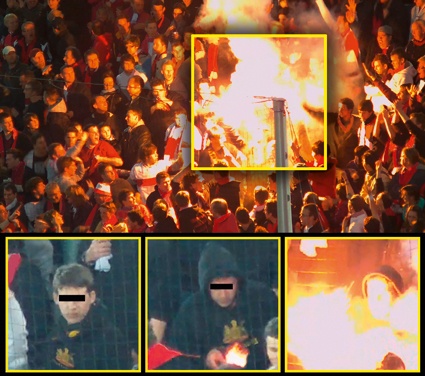Video Technology: Latest Technology for Stadium Security
These days, video technology has become an indispensable element of the security arrangements in sports stadia. With its introduction of the Panomera multifocal sensor system, Ge...


These days, video technology has become an indispensable element of the security arrangements in sports stadia. With its introduction of the Panomera multifocal sensor system, German developer and manufacturer Dallmeier has unveiled an entirely new approach to video surveillance of large areas. This technology offers many advantages for those responsible for stadium security. We spoke with Roland Meier, team leader Panomera Multifocal Sensor Systems at Dallmeier.
GIT-SECURITY.com: Mr. Meier, what is so innovative about the Panomera system?
Roland Meier: With the Panomera multifocal sensor system, a huge area can be monitored from a single location extremely efficiently. The most impressive aspect of the product is that it combines the overall view with simultaneous top detail resolution: Even more distant objects are displayed with the same resolution as objects in the foreground of the picture.
What advantages does this have for monitoring stadia?
Roland Meier: Panomera works well both for very wide panoramas and for areas involving great distances. An entire stadium can be monitored permanently with just two Panomera systems! In effect, it is as if you were to combine the advantages of an overview camera and a high optical zoom PTZ camera: Panomera records the entire area continuously, like an overview camera - unlike a PTZ camera for example, with which only the currently active zoom area is recorded. But at the same time you can move and zoom anywhere in the entire coverage area - and individuals are clearly recognizable even at distances of more than 160 m.
If the entire scene is monitored by just one camera, is it only possible for one security operator to work with the camera or can several operators access it?
Roland Meier: In contrast to PTZ cameras, with which only one operator can control the camera, with Panomera, an unlimited number of operators can navigate across the entire scene independently of each other. Although all operators are connected with the same camera, each of the individual users can select his view individually and zoom or pan as he desires. Or he can perform evaluations of the recordings at the same time. So analyses can be carried out by any number of employees at various workstations simultaneously, for example one may be watching the overview image live, another may zoom in on suspicious fans in real time, while yet another is looking at the recording from an hour ago to see how the stadium filled up.
Do you not need enormous bandwidth for this?
Roland Meier: Owing to the so-called multicast capability several users can view the images from Panomera without requiring repeated transmission of the data via network. This reduces the necessary bandwidth significantly.
How fluidly is movement represented in the images?
Roland Meier: Panomera provides image material in real time and at high frame rates of up to 30 fps, which translates to completely fluid representation. And quite honestly: If a video system is really going to help shed some light on certain incidents, that is absolutely imperative. For example, imagine someone lit a Bengal firework and you now want to find out who did it. Now, if you have a camera that is only recording one image per minute, at best you might be able to see which direction the Bengal firework came from, but you would not be able to identify the perpetrator individually. On the other hand, with Panomera you can step back one image at a time through the recording until you can see exactly who lit the firework.
That all sounds very plausible, but at the same time extremely complex...
Roland Meier: Quite frankly, it is difficult to describe Panomera in words and explain all of its features. You simply have to see it in action for real. I have had that experience very often when making presentations to customers: Everyone who sees the system with his own eyes very soon has that "Aha" moment. We call it the "Panomera effect": Panomera far surpasses the limits of conventional cameras. That is why we are constantly stressing that Panomera is not just another camera that purports to offer more megapixels than the products of our competitors. That is not the point - Panomera represents an entirely new technology and a fundamentally different approach to the issue of video security.
What is the situation regarding price? A system like this must surely be very expensive.
Roland Meier: Not at all: Panomera is the most cost-effective system on the market today! Of course, a Panomera is more expensive than a single conventional HD camera. But then you only need one Panomera system to cover the same area that previously required several cameras. Even so, the greatest savings are realized in expenses for the infrastructure. This really cannot be overemphasized. The most expensive factor in installing a camera is not the camera itself, but the infrastructure it needs, that is to say: camera masts, wiring, electricity supply and so on. If you only need a single camera installation site, you save an enormous amount of money. For this reason alone, it would pay immense dividends to thoroughly calculate the cost of a Panomera-based project!
Would an existing video system have to be replaced completely if a stadium opts for a new Panomera solution?
Roland Meier: No, existing cameras can be incorporated in the Panomera concept. For example, a stadium may decide initially to use Panomera to cover the home and visiting fan area, which need to be monitored particularly closely, while the other areas can be monitored as before using the cameras already in place. Even so, the entire video system can be monitored and controlled using a single management system.
Or, the most practical solution may be to continue using existing PTZ cameras in the visiting fan area, and to integrate them in the Panomera solution. That is easily possible with our SeMSy management system. The movable cameras can be automatically directed at the desired point with a simple click of the mouse at the Panomera station. Now the incident in question can be viewed not only via the Panomera but through the PTZ cameras as well. This enables a different field viewing angle, for example if individuals happen at the moment to be hidden behind a banner, or again the activity can be displayed in greater resolution. So the two systems work very efficiently together!
And while we are on the subject of integration: a mobile solution can be created without difficulty via our iPhone server. The images from Panomera can be displayed on an iPhone or iPad, for example, so that the security forces inside the stadium can have immediate access to pictures of anyone behaving unacceptably. This results in faster response times and greater flexibility.
Dallmeier already has many references from stadium sites all over the world...
Roland Meier: That is true. Projects we have already completed range from smaller regional stadia all the way up to enormous arenas such as the Soccer City Stadium in South Africa, where the opening ceremony and the final match of the 2010 Football World Cup were held. Or the Olympic Stadium in Athens. Incidentally, in Greece we have fitted out a total of 22 stadia with our equipment - and all 22 sites are controlled from a common control center! This multisite capability is also made possible by flexible IP technology. We do not mass produce products, we manufacture individually planned solutions that are tailored precisely to meet the needs of the respective customer and his specific requirements, for example with regard to resolution quality, storage capacity, or budget.
What is the situation regarding investment security? After all, development cycles for new technologies are becoming shorter and shorter...
Roland Meier: Owing to the open system architecture of the Dallmeier solutions the video system remains flexible and scalable. Future expansions or modifications are easily possible, even hybrid operation with devices from different generations presents no problems. Hence the stadium solutions by Dallmeier offer long-term investment protection.
most read

Security management, building security & perimeter protection: the winners of category E at the GIT SECURITY AWARD 2026
GIT SECURITY AWARD 2026: Security management, building security & perimeter protection - an overview of the most innovative solutions

GIT SECURITY AWARD 2026 - The winners have been announced!
GIT SECURITY AWARD 2026: The best safety and security solutions of the year - now an overview of all winners

Video security & video management: the winners of category C at the GIT SECURITY AWARD 2026
GIT SECURITY AWARD 2026: Video Security & Video Management - an overview of the most innovative solutions


Integrated and Futureproof: Traka’s Next Chapter
Interview with Stefni Oliver on Traka’s Vision for the Future









